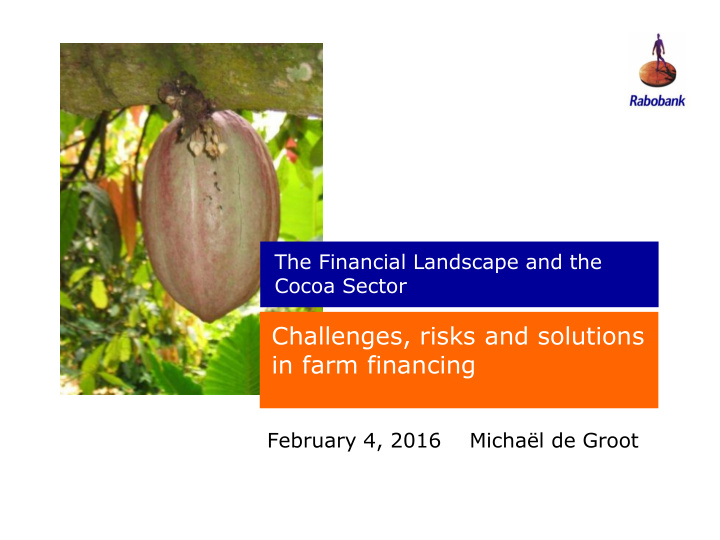



The Financial Landscape and the Cocoa Sector Challenges, risks and solutions in farm financing February 4, 2016 Michaël de Groot
Not all agri production is bankable in developing countries Corporate farmers bankable Emergent farmers Subsistence non bankable farmers/small holders Cocoa production is for 90% concentrated in the lower part of the pyramid 2
Features per farmer segment • Land title/collateral • Access to finance Corporate farmers • Financial literate • Good financial documentation • Sometimes land title • Some collateral Emergent farmers • Moderate financial literacy • Developing financial documentation • Some access to formal finance • No land title/collateral Subsistence • Land use rights farmers/small holders • No financial literacy • No financial documentation • No access to formal finance Cocoa production is for 90% concentrated in the lower part of the pyramid 3
Financing of 500 million smallholders Informal credit from family/neighbors/local shopkeepers • Informal credit from middle-men/ off-takers • – Lack of bargaining power – Barter deals: inputs against crop – Or cash under high interest rates – Lack of transparency – Creates dependency on middle-men Semi- formal credit from producer organizations, co-operatives • Sometimes state bank programs • No or very little access to formal bank credit 4
Financial services Commercial banks More sophisticated financial services for High MCEs Development banks, Middle Agricultural banks, Savings banks Standard financial services for SMEs Low income MFIs, Credit unions, Credit cooperatives Microfinance services for MSEs NGOs, Self help groups, Moneylenders Economic active poor Official poverty line Grants Extreme poor NGOs, Governments 5
Main obstacles to formal credit to individual farmers Farm level Lack of collateral/land title/capital • Lack of financial documentation • Lack of track-record • Lack of understanding bank requirements • Institutional level Government policies • Lack of supporting legislation (e.g. warehouse receipt laws, enforceability of • collateral) Bank level Lack of understanding of agriculture markets • Large distance between bank branch and farmers • Mismatch in financial products and sector needs • High risk in financing agriculture • 6
What are the main risks associated with agriculture? Commodity price risk • Quality differences, perishable goods • Crop risk (weather, diseases) • Weak repayment discipline / cash diversion / theft • Lack of collateral and is difficult to liquidate • Political risk (government interventions, legal enforceability of rights) • 7
What are the credit needs of the individual farmers? Mainly working capital finance / seasonal credit • – Planting materials – Farm inputs (chemicals & fertilisers) – Labour LT loans for renewal plantations / productivity / equipment • Lack of credit is resulting in low use of inputs, no replanting resulting in low productivity and quality 8
Our view on how to address these obstacles for the individual farmer Create bargaining power via: • – Creating economies of scale !!! (size) – Integration in the value chain ! – Organise “what you can do better together” – Knowledge transfer (extension services) – Marketing – Input supply – Finance Most common solution to this is a cooperative organisation and integration in the supply chain 9
The cocoa and chocolate value chain… Cocoa Cocoa Trading/ Branded Food Inputs shipping Processing farming sourcing choc. retail Consumers Choc. Food Food Manufac- companies service turing 1st transformation 2nd transformation Institutions Grinding Pressing from cocoa beans from cocoa liquor to cocoa to cocoa liquor butter and cocoa powder De-coupling point Cocoa industry Chocolate industry Sector analysis cocoa and chocolate Industry 10
Current financing options for coops are limited in developing countries Financing needs Which parties are active? Investment finance (medium/long-term): Scarce equity and foreign direct investment • land, warehousing, equipment, Governments transportation, cost of certification, etc Social lenders • Input financing: to finance the purchase of middle men, (Inter)national traders inputs on behalf of the members Stock financing: to finance the beans stored Expensive due to lack of warehouse receipt • at the coop warehouse before delivery systems and enforceability local banks Risk of double pledging Pre-(export) finance of harvest: to bridge Available at competitive rates • period between purchase from members main provider international traders and and payment by off-takers local banks 11
Which interventions are needed to improve the situation? Cooperatives/ SME should be better prepared for their tasks by Cooperative Institutional Capacity building • Implementation of a proper capitalization structure • Improving member loyalty • Access to markets and information, agronomic support, exchange of best • practices Banks should be better prepared to financing the cocoa sector Knowledge transfer to local banks (training of agri credit skills, understanding of • agri markets and cooperatives) Temporary credit enhancement through risk sharing instruments/guarantees • (by governements/mulitlaterals) 12
Rabobank Rural Fund business cases Asset Finance Farmers Coops Processors Traders • Save For Loan • Input financing • Working Capital • Credit score cards • Raw Material • WHR financing Collection Financing • Outgrower schemes • Trade & Commodity • WHR financing Finanance • Emerging farmer • Cooperative capacity programs building 13 Working capital
Thank you Michaël de Groot Rabo Rural Fund email: michael.de.groot@rabobank.nl
Recommend
More recommend